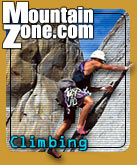
|
The Equatorial Bulge Climbing Ecuador's Volcanoes February 27th, 2006
From the upper hut at 16,200 feet, find the obvious trail network, which leads up to the rock cliff that supports the lower glacier. The short step required to attain the glacier from the rock is notoriously gnarly, but an easy class 3 move is all that's currently needed to surmount it. Once above the cliff, traverse to the right, following crampon tracks and an occasional flag, until you arrive at a thick snow embankment, where most people rope up (don't traverse too far to the right, as the slopes are covered with verglas). Immediately beyond the embankment, the route steepens considerably. The trick to this climb is quickly and efficiently gaining the northwest ridge from the lower glacier. It's a convoluted route, but you can probably follow footprints and wands to arrive at a broad shoulder just above a big rock (called El Castillo) at about 18,000 feet. There are two general routes that will get you to the shoulder; one ascends to the right of a massive rock protrusion embedded in the glacier, the other goes to the left. Don't be afraid to let your route-finding senses guide you, and be wary of following others (especially large, slow parties), unless you're sure they know where they're going. From the shoulder, the route is wanded about every 300 vertical feet, so there is little chance of getting lost. The northwest ridge varies drastically in steepness, ranging from as little as 30 degrees to as much as 50. It probably averages 38 degrees or so, somewhat steeper, but far less crevassed, than Cayambe's southwest route. There are four false summits on the upper part of the ridge. Each is a shelf of ice above a steep section. The final steep section deposits you on the edge of a featureless pancake—from here it is a 150-yard jaunt over windswept snow to the almost unnoticeable hump of Veintimilla. This section is unprotected from the elements, so take care not to get blown off the mountain. From Veintimilla, the Whymper summit is over a half-mile away, but the net elevation gain is less than 200 feet. If you have time and if you still feel eager, go for it. Strong parties can make it in 30 minutes. In January 2003, there was a nasty 50-foot deep, four-foot wide crevasse encircling the entire summit, and it was guarded on both sides by three-foot high drifts of very unstable snow. There were no good bridges across the crevasse, and there was no way to jump it, since the cruddy snow offered no firm purchase. At the time, the only sure way across this gap was with a ladder. Thankfully, this crevasse is located only 20 vertical and 80 horizontal feet away from Whymper's highest point, so even if you don't get across, you are so close to the summit that you can claim victory in your climbing memoirs anyway. Most people will be satisfied with this accomplishment; only about a fifth of all climbers who summit Veintimilla even bother trying for Whymper.
Logistical Details Costs Haciendas » Page 5
|
||||||||||||
IN THE NEWS |
|
| |
|
